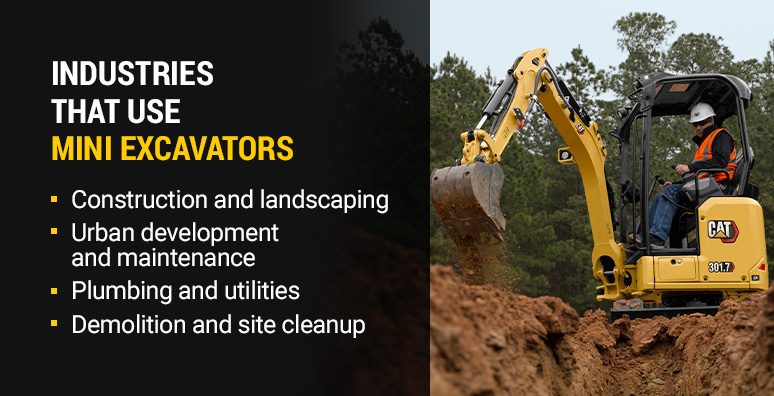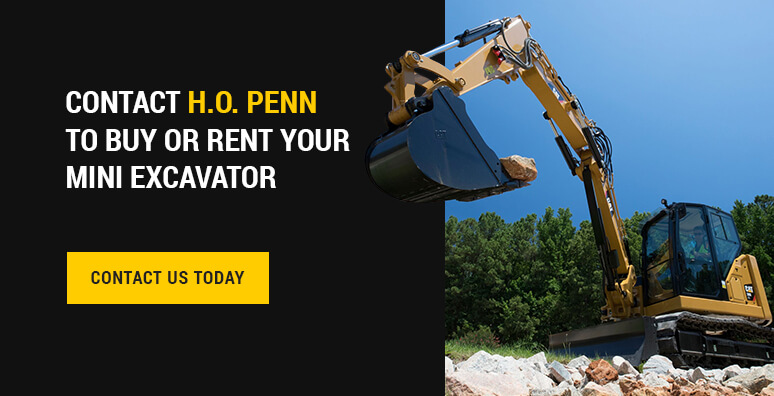Among the many tools at a project manager’s disposal, the mini excavator emerges as a compact yet mighty contender. Its agile design and ability to handle intricate work open a world of possibilities tailored to specific project demands. From confined urban spaces to delicate landscaping sites, the mini excavator’s presence gives operators the finesse they need to complete jobs with precision.
Knowing when to use a mini excavator will ensure you can take on big jobs as well as those requiring a deft touch.
Mini Excavator Parts
To understand what makes a mini excavator a good addition to your fleet, look at the parts that form its mechanical anatomy and power its functions:
- Cab and operator controls: In the center of the mini excavator is its operator’s cab, where controls and instruments are strategically positioned for efficient operation. Joysticks, pedals, levers and buttons allow the operator to direct various movements and functions of the machine.
- Boom, arm and bucket: The boom, arm and bucket facilitate excavation and lifting. The boom extends upward while the arm articulates to reach out. The bucket, attached to the arm, is the primary tool for digging, scooping and material handling. Operators can also replace the bucket with other tools such as grapples to accomplish different tasks.
- Hydraulic system: The hydraulic system comprises pumps, cylinders, hoses and valves. The system converts hydraulic energy into mechanical force, enabling precise control over movements and attachments.
- Engine: The engine converts fuel into mechanical energy to power the hydraulic system and propel the machine’s movements.
- Swing mechanism: The swing mechanism lets the mini excavator rotate 360 degrees. It comprises a hydraulic motor and gearing system that allows the upper structure to pivot on the undercarriage for positioning.
- Counterweight: The counterweight is strategically placed to balance the excavator during operation. It offsets the weight of the boom, arm and attachments, ensuring stability and preventing tipping.
Mini vs. Standard Excavators
These two distinct machines cater to different project requirements. To make an informed choice between the different excavator models, you must understand their differences and match their strengths with project demands.
The Mini Excavator
The modern mini excavator can go almost anywhere thanks to its compact design and maneuverability. It thrives in environments where space is limited, making it ideal for urban settings and tasks like landscaping, utility work and minor demolitions in tight spaces. Its hydraulic systems allow for delicate operations that require finesse.
Learn what a mini excavator is and where it works best by looking at the following key features and attributes:
- Maneuverability: This small machine’s compact size grants it unparalleled maneuverability. It can easily navigate through tight spots, narrow passageways and confined areas where larger equipment would struggle to fit.
- Versatility: Despite its smaller stature, the mini excavator is multifunctional. It can tackle tasks including trenching, digging, landscaping and utility work.
- Hydraulic precision: Equipped with advanced hydraulic systems, the mini excavator offers precise control over its movements and attachments. This enables operators to perform delicate operations with accuracy and finesse.
- Weight considerations: The reduced weight of the mini excavator minimizes its impact on delicate surfaces, making it suitable for tasks that require care and preservation of the surroundings.
The Standard Excavator
On the other end of the spectrum, the standard excavator has more power and lifting capacity than the mini version. It excels in projects requiring significant earthmoving, digging and lifting capabilities. Its larger size and extended operational range make it perfect for foundation digging, large-scale trenching and substantial demolition work.
A few noteworthy attributes and features include:
- Lifting capacity: One of the defining features of the standard excavator is its exceptional lifting capacity. Equipped with a robust hydraulic system, it can effortlessly hoist and maneuver heavy loads, making it an ideal choice for tasks that require significant lifting power.
- Extended operational reach: The standard excavator boasts a long reach and digging depth, equipping it to take on demanding projects that require large amounts of material to be moved efficiently.
- Durability: Built for heavy-duty tasks, the standard excavator is designed to withstand rigorous use. Its sturdy construction ensures longevity even when subjected to harsh work environments.
- Attachment compatibility: This size of excavator is also compatible with various attachments, allowing it to adapt to different tasks. Attachments such as buckets, hammers and grapples enhance its capabilities and broaden its utility.
Industries That Use Mini Excavators
The mini excavator is prized for its maneuverability and compact design. These attributes make it indispensable in industries and projects that frequently call for precision earthmoving within confined spaces, such as:

- Construction and landscaping: Landscapers often use mini excavators to create contours, install irrigation systems and shape terrain meticulously.
- Urban development and maintenance: Urban development projects such as sidewalk repairs, street maintenance and utility installations often necessitate working within tight confines. The agility of mini excavators allows them to navigate through narrow streets and alleys, ensuring that essential urban services remain uninterrupted.
- Plumbing and utilities: Mini excavators offer the control required to excavate around pipes and underground infrastructure without causing unnecessary damage.
- Demolition and site cleanup: These compact machines are excellent for site cleanup jobs, enabling efficient removal of debris, rocks and other materials and making way for new developments.
How to Use a Mini Excavator
Whether you’re a seasoned operator or a novice, using a mini excavator correctly promotes safety, efficiency and successful project outcomes. If you’re new to these machines and the many jobs you can do with a mini excavator, it’s best to start with the basics of how to use one.
- Climb into the operator’s cabin and fasten your seat belt. Adjust the seat and mirrors for optimal visibility. Familiarize yourself with the control layout, including joysticks, pedals and switches. Ensure all controls are in the neutral position before starting the engine.
- Once everything has been checked, you can start the engine according to the manufacturer’s instructions. It is always good to practice basic movements in an open area. Use the joysticks to control the boom’s up-and-down movement, the arm’s extension, and the bucket’s opening and closing. Familiarize yourself with the track controls for forward, backward and turning motions.
- As you gain confidence, start combining movements. For instance, practice digging using coordinated joystick movements to lower the bucket, extend the arm and move the boom. Focus on smooth and controlled actions.
- When performing excavation tasks, maintain a safe distance from the edge of the excavation site. Dig in layers, gradually removing material. Avoid overloading the bucket to prevent tipping or damaging the machine.
Contact H.O. Penn to Buy or Rent Your Mini Excavator
For over a century, H.O. Penn has upheld a reputation for exceptional customer service, constant improvement and a commitment to our customers’ success. The construction industry is constantly evolving, and our team is here to ensure you have the machinery, tools and support you need to do your best work and grow your business.
H.O. Penn serves customers throughout New York and Connecticut, providing premium Cat® equipment sales, rentals and service. Whether you need a new earthmover, a rental to cover temporary needs or more insight on using a mini excavator to its greatest effect, contact the professionals at H.O. Penn today.

